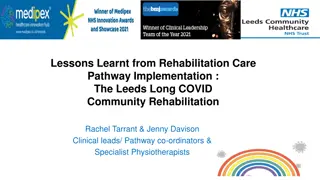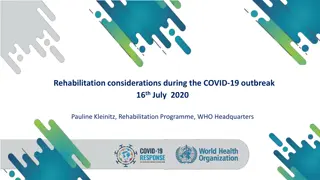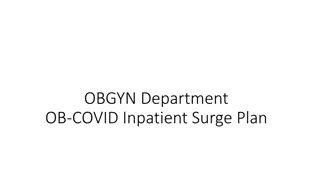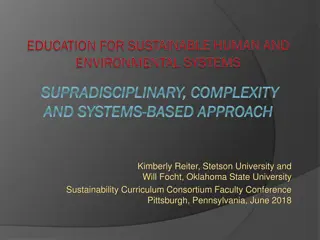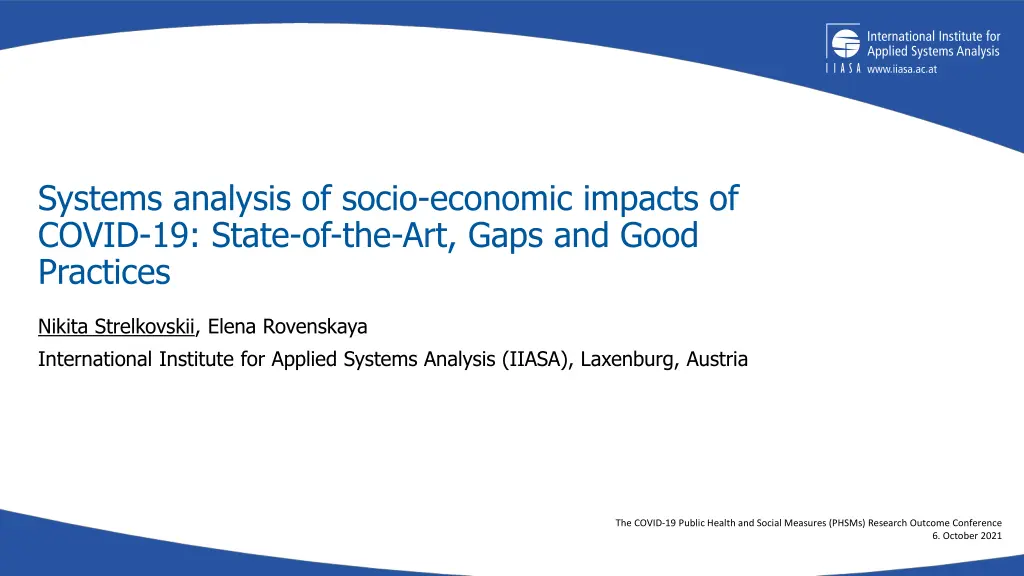
Understanding the Socio-Economic Impacts of COVID-19: Systems Analysis Approach
Explore the state-of-the-art analysis of the socio-economic impacts of COVID-19 through systems thinking and mapping. Learn how a holistic approach is crucial in addressing the complexity of the crisis and find out about the latest research on this critical issue.
Download Presentation

Please find below an Image/Link to download the presentation.
The content on the website is provided AS IS for your information and personal use only. It may not be sold, licensed, or shared on other websites without obtaining consent from the author. If you encounter any issues during the download, it is possible that the publisher has removed the file from their server.
You are allowed to download the files provided on this website for personal or commercial use, subject to the condition that they are used lawfully. All files are the property of their respective owners.
The content on the website is provided AS IS for your information and personal use only. It may not be sold, licensed, or shared on other websites without obtaining consent from the author.
E N D
Presentation Transcript
Systems analysis of socio-economic impacts of COVID-19: State-of-the-Art, Gaps and Good Practices Nikita Strelkovskii, Elena Rovenskaya International Institute for Applied Systems Analysis (IIASA), Laxenburg, Austria The COVID-19 Public Health and Social Measures (PHSMs) Research Outcome Conference 6. October 2021
Complexity of the COVID-19 crisis Employment ? Well-being Number of (active) COVID-19 cases ? Mental health NPIs ? New technologies A complex system: Cannot be explained by breaking it down into components due to their strong interdependency Source: Cairney, 2012. Complexity Theory in Political Science and Public Policy, Political Studies Review, 10(3) 346-358 Interdisciplinary in nature 6. October 2021 2
Systems thinking Systems thinking and holistic approach are needed to find effective nexus solutions and to reduce risks of unwanted consequences in complex systems COVID-19 means systems thinking is no longer optional Seth Reynolds Systems thinking is based on analyzing causal interconnections, indirect effects and feedback loops Decision makers can be assisted by formal tools of qualitative systems thinking, which can help reveal tradeoffs and synergies Formal tools can also help reduce wickedness of the problem and discipline a dialogue 6. October 2021 3
Systems maps (causal loop diagrams) A link (arrow) represents a causal relation between two factors. A link from A to B implies that if A changes, as a result B will change, too. A link polarity denotes the direction of the relationship between two factors. A positive causality between A and B means that the change in B is in the same direction as A. A negative causality means that the change in B is in opposite direction. Causal link + Link polarity Source: Sahin, O.; Salim, H.; Suprun, E.; Richards, R.; MacAskill, S.; Heilgeist, S.; Rutherford, S.; Stewart, R.A.; Beal, C.D, 2020. Developing a Preliminary Causal Loop Diagram for Understanding the Wicked Complexity of the COVID-19 Pandemic. Systems, 8, 20, doi:10.3390/systems8020020. A B - Factor (Variable) 6. October 2021 4
Systems mapping to address the COVID- 19 crisis: a review About 10 academic papers assessing COVID-19 impact on a wider socio-economic systems published to date Number of components: 17 78 (mean: 34) Number of links: 34 125 (mean: 61) Sources: expert workshops and literature Research questions 6. October 2021 5
COVID-19-relevant system components in the reviewed studies Common: Rare: Number of actually infected people and diagnosed cases Environmental impact (e.g., waste generation) Number of COVID-19 deaths Social tensions (lack of trust, home violence, racism) Panic and/or fears Role of research institutions Business closures (lockdowns) Role of vaccines Unemployment Social and economic inequality Impact on the healthcare system Social distancing 6. October 2021 6
Types of system components Active components most links outgoing (high out- degree) Passive components most links incoming (high in- degree) Critical buffers both (several) incoming and outgoing links (high total degree) Source: Vester, F., 2007. The art of Interconnected Thinking; MCB Publishing House: M nchen, Germany. 6. October 2021 7
Feedback loops A feedback loop is a sequence of links connecting components by forming a cycle Reinforcing feedback loop an initial increase/decrease of the state of any component further increases/decreases after every cycle Balancing feedback loop an initial increase/decrease of the state of any component decreases/increases after every cycle. Identifying feedback loops is a primary analysis method of systems maps Source: Bahri, M., 2020. The Nexus Impacts of the COVID-19: A Qualitative Perspective. Preprints, 2020050033, doi:10.20944/preprints202005.0033.v2 Source: Tonnang, H.; Greenfield, J.; Mazzaferro, G.; Austin, C.C., 2020. COVID-19 Emergency Public Health and Economic Measures Causal Loops: A Computable Framework. SSRN Electron. J., doi:10.2139/ssrn.3686027. 6. October 2021 8
Systems thinking is good, but hard Human brains have limited ability to execute systems thinking (Levy et al., 2018) Prevalence of network motifs compared to random networks as a measure of systems thinking (Aminpour et al., 2021) Bidirectionality Multiple causes Multiple effects Indirect effect Moderated effect Feedback loops Overrepresented Underrepresented Underrepresented Underrepresented Balanced Overrepresented Systems maps might be biased by their authors expertise, beliefs and values Could quantitative data be used? 6. October 2021 9
Systems maps applications (not only COVID-19) Sense-making, understanding of indirect and feedback effects of policies Systemic (better) decision-making Identification of leverage points Development of simulation models, e.g., systems dynamics IIASA ongoing project: systems mapping of impacts of COVID-19 NPIs on national well- being 6. October 2021 10
Thank you for your time! Questions? Nikita Strelkovskii Advancing Systems Analysis (ASA) program strelkon@iiasa.ac.at









